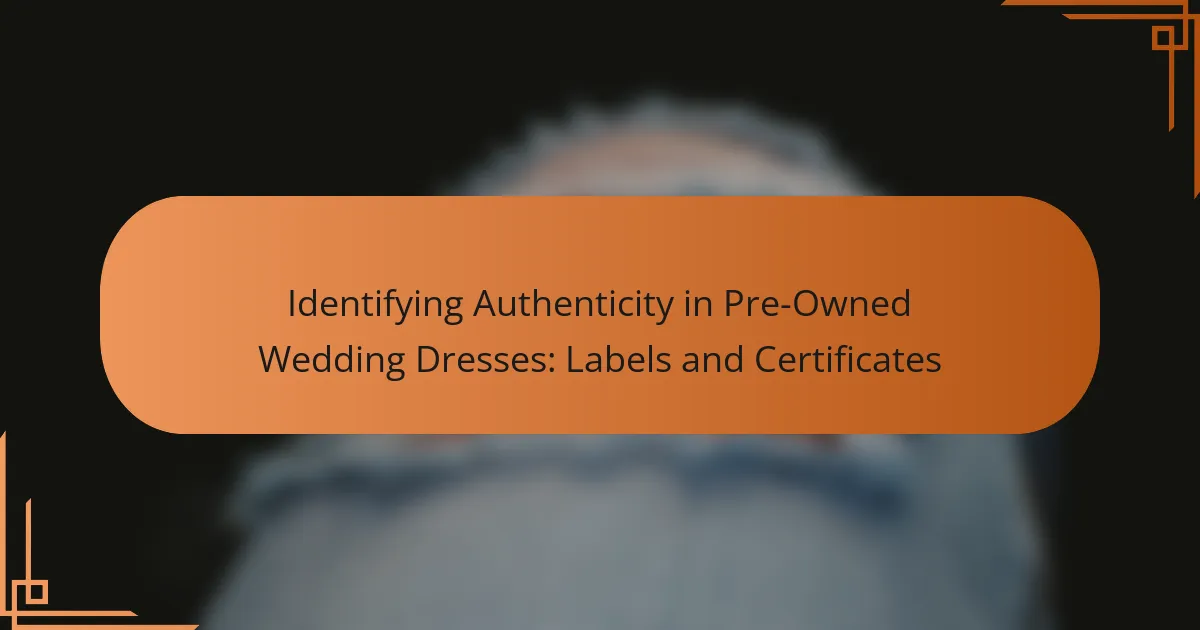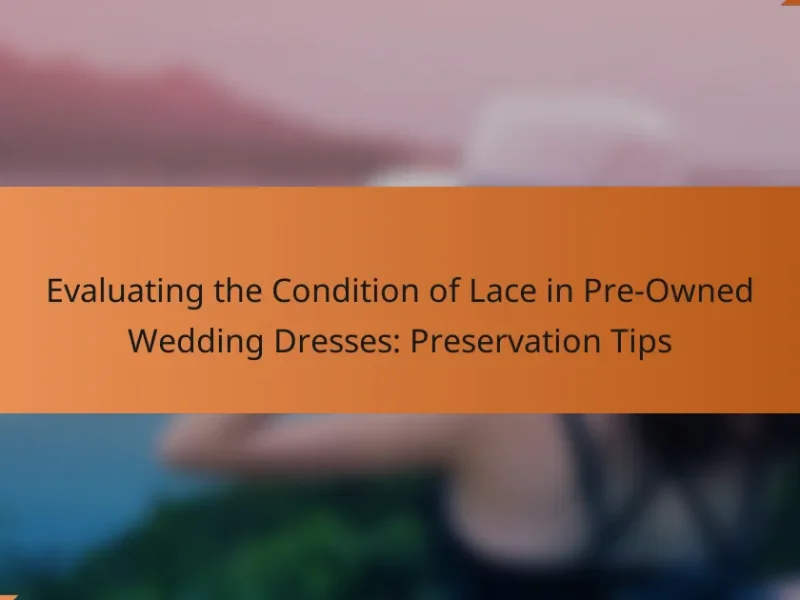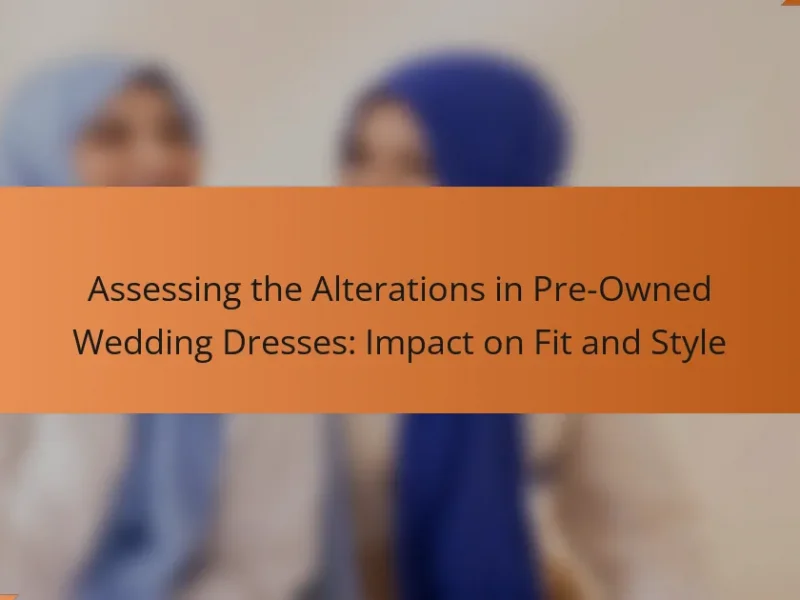Authenticity in pre-owned wedding dresses is crucial for verifying the original designer and ensuring the dress’s genuine characteristics. Key factors in establishing authenticity include checking for original labels, tags, and certificates that confirm the dress’s provenance, such as the designer’s name and unique identifiers like serial numbers. Buyers should inspect the dress for high-quality stitching, request original purchase receipts, and research the designer’s specifics. Additionally, understanding the seller’s credibility and the dress’s condition is essential, along with verifying return policies and potential alterations. This comprehensive approach helps ensure the purchase of a legitimate, high-quality wedding dress.
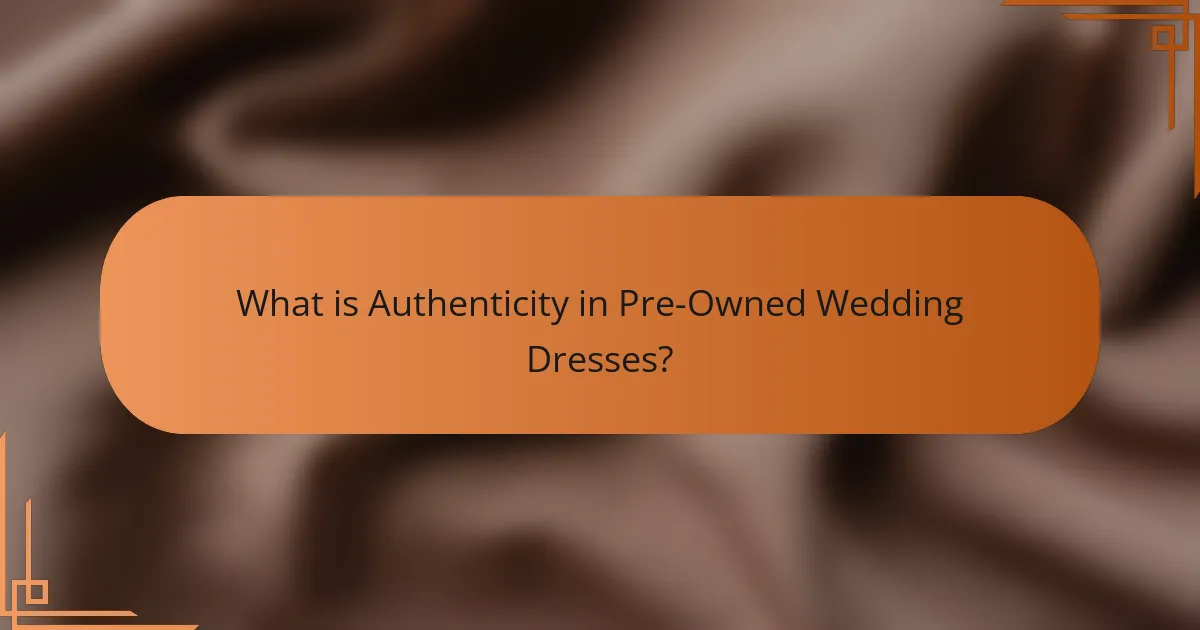
What is Authenticity in Pre-Owned Wedding Dresses?
Authenticity in pre-owned wedding dresses refers to the verification of the dress’s original designer and its genuine characteristics. This involves checking labels, tags, and certificates that confirm the dress’s provenance. Authenticity ensures that the dress is not a counterfeit or replica. It may include details such as the designer’s name, the dress’s production year, and unique identifiers like serial numbers. Many reputable brands provide authenticity certificates with their dresses. Additionally, established resale platforms often have authentication processes in place. These measures help buyers ensure they are purchasing a legitimate, high-quality item.
Why is it important to identify authenticity in pre-owned wedding dresses?
Identifying authenticity in pre-owned wedding dresses is crucial for ensuring quality and value. Authentic dresses often come from reputable designers with established craftsmanship. This authenticity guarantees that the materials and construction meet high standards. Additionally, verified authenticity protects buyers from counterfeit products that may be of inferior quality. It also preserves the dress’s resale value, as authentic pieces typically retain their worth better than replicas. Buyers can feel confident in their purchase when authenticity is confirmed through labels and certificates. This process minimizes the risk of fraud and enhances customer satisfaction in the wedding dress market.
What are the potential risks of purchasing non-authentic pre-owned wedding dresses?
Purchasing non-authentic pre-owned wedding dresses carries several potential risks. Firstly, the quality of materials may be substandard, leading to a dress that does not last. Secondly, non-authentic dresses may not fit properly due to inaccurate sizing. This can result in additional alteration costs. Thirdly, there is a risk of deceptive practices, such as misrepresentation of the dress’s designer or brand. Buyers may also face issues with the dress’s condition, including hidden damages or stains. Additionally, non-authentic dresses might lack proper care instructions, affecting their maintenance. Lastly, purchasing such dresses can lead to emotional distress if the buyer discovers the deception after the purchase.
How does authenticity impact the value of pre-owned wedding dresses?
Authenticity significantly enhances the value of pre-owned wedding dresses. Authentic dresses often come with original labels or certificates of authenticity. These indicators provide proof of the dress’s origin and designer. Buyers are willing to pay a premium for verified authentic items. The presence of authenticity can increase resale value by up to 30%. Conversely, dresses lacking proof of authenticity may sell for much less. Buyers prioritize trust and assurance in their purchase decisions. Authenticity assures them of quality and craftsmanship. This demand for authenticity directly correlates with higher market values.
What labels and certificates signify authenticity?
Labels and certificates that signify authenticity include designer labels, authenticity certificates, and care labels. Designer labels indicate the brand and often include details about the item. Authenticity certificates are issued by the brand or a trusted third party, confirming the item’s legitimacy. Care labels provide information on the materials and care instructions, which can also help verify authenticity. These elements are essential in the resale market for pre-owned wedding dresses. They help buyers ensure they are purchasing genuine items.
What types of labels should you look for in pre-owned wedding dresses?
Look for designer labels, fabric content labels, and care labels in pre-owned wedding dresses. Designer labels indicate the brand and can signify quality and craftsmanship. Fabric content labels provide information on materials used, which affects the dress’s durability and comfort. Care labels outline cleaning instructions, essential for maintaining the dress’s condition. Authenticity can also be verified through original tags or certificates of authenticity. These labels help ensure you are purchasing a genuine item.
How can certificates of authenticity enhance trust in a purchase?
Certificates of authenticity enhance trust in a purchase by providing verified proof of an item’s legitimacy. These certificates serve as official documentation that confirms the originality of the product. They reduce the risk of fraud by ensuring that the buyer receives a genuine item. In the context of pre-owned wedding dresses, certificates can detail the dress’s designer, history, and condition. This transparency builds buyer confidence and assures them of their investment. Studies show that products with authenticity certificates are perceived as more valuable. This perception can lead to higher customer satisfaction and loyalty.
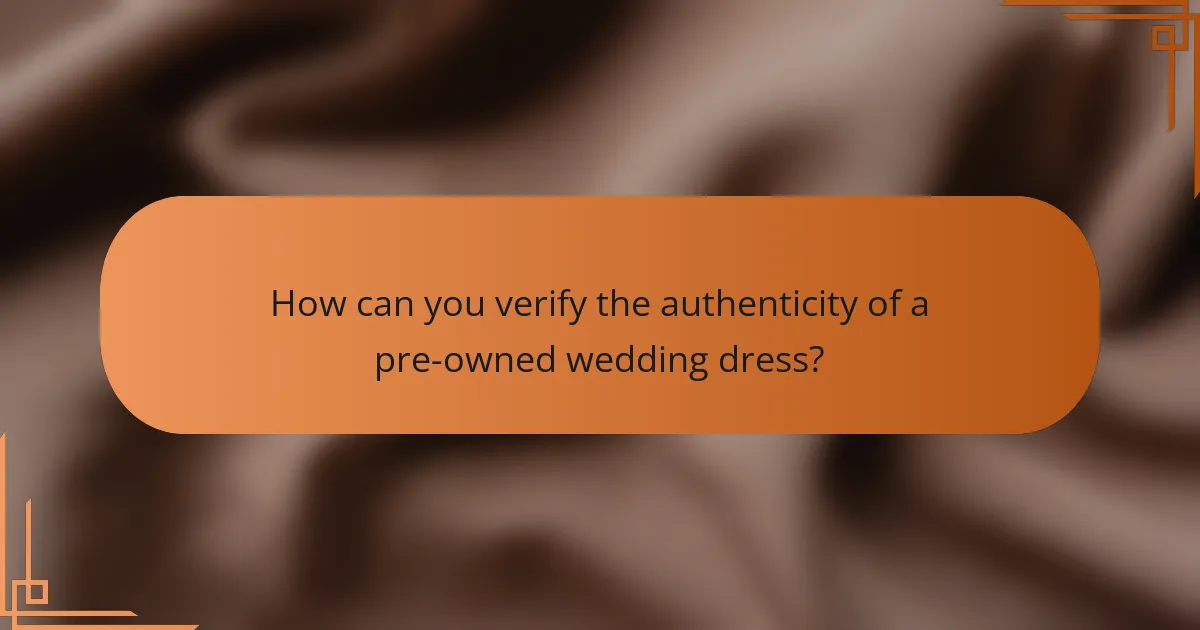
How can you verify the authenticity of a pre-owned wedding dress?
To verify the authenticity of a pre-owned wedding dress, check for original labels and certificates. Authentic wedding dresses typically have designer labels sewn into the garment. Look for a care label that includes the brand name and care instructions. Examine the stitching quality; high-end dresses often feature precise and consistent stitching. Request any original purchase receipts or certificates of authenticity from the seller. Research the designer’s specific details, as each brand has unique identifiers. Compare the dress to official images from the designer’s website. If possible, consult with a bridal boutique or a professional appraiser for an expert opinion. These steps help ensure the dress’s authenticity and value.
What steps should you take to inspect labels and certificates?
To inspect labels and certificates, start by examining the label for brand details. Verify the brand name, logo, and any specific identifiers. Check for care instructions and fabric content, which should align with the brand’s standards. Next, review the certificate for authenticity. Ensure it includes the designer’s signature or a unique serial number. Compare the certificate details with the dress’s characteristics. Look for signs of tampering or inconsistencies in the information provided. Authentic brands often have specific formatting or holograms on their certificates. Finally, consult online resources or expert reviews to confirm the authenticity of the label and certificate.
How do you differentiate between genuine and counterfeit labels?
Examine the label’s quality and details to differentiate between genuine and counterfeit labels. Genuine labels typically have high-quality materials and precise stitching. Counterfeit labels often show signs of poor craftsmanship. Check for the brand’s logo and font accuracy. Authentic brands maintain consistent logo design and color. Look for unique identifiers like serial numbers or holograms. Many authentic labels include these features for verification. Research the brand’s labeling standards online. Most reputable brands provide guidelines on identifying authentic labels.
What are the key features to examine on a certificate of authenticity?
Key features to examine on a certificate of authenticity include the issuer’s name and contact information. This information verifies the authority behind the certification. The certificate should contain a unique identification number or code. This number helps trace the item back to its original source. Additionally, the date of issue is important for establishing the timeline of authenticity. The description of the item, including details like brand and model, should also be present. Signatures or stamps from the issuing authority add credibility. Lastly, any specific terms or conditions related to the authenticity should be clearly stated. These features collectively ensure the certificate’s reliability and validity.
What resources are available for verifying authenticity?
Resources available for verifying authenticity include certification bodies, brand registries, and expert appraisers. Certification bodies provide official documentation confirming the authenticity of items. Brand registries maintain records of legitimate products and their respective identifiers. Expert appraisers possess specialized knowledge to assess and validate the authenticity of wedding dresses. Additionally, online databases can offer insights into registered labels and past collections. These resources collectively ensure that buyers can confidently verify the authenticity of pre-owned wedding dresses.
How can online databases assist in verifying wedding dress authenticity?
Online databases assist in verifying wedding dress authenticity by providing access to brand-specific information and records. These databases often include details about design, materials, and production dates. Users can cross-reference dress attributes with official brand data. This helps identify counterfeit items by matching unique identifiers like labels and serial numbers. Many reputable designers maintain online registries to confirm authenticity. Additionally, user-generated content on these platforms can offer insights and experiences related to specific dresses. Therefore, online databases serve as a valuable resource for confirming the legitimacy of pre-owned wedding dresses.
What role do bridal boutiques play in authenticity verification?
Bridal boutiques play a crucial role in authenticity verification for pre-owned wedding dresses. They assess the quality and condition of the dresses before resale. Many boutiques have trained staff who can identify genuine designer labels. This expertise helps prevent counterfeit sales. Additionally, bridal boutiques often provide certificates of authenticity for verified dresses. These certificates serve as proof of the dress’s origin. The presence of such documentation enhances buyer confidence. Bridal boutiques act as intermediaries between sellers and buyers, ensuring transparency in the transaction.
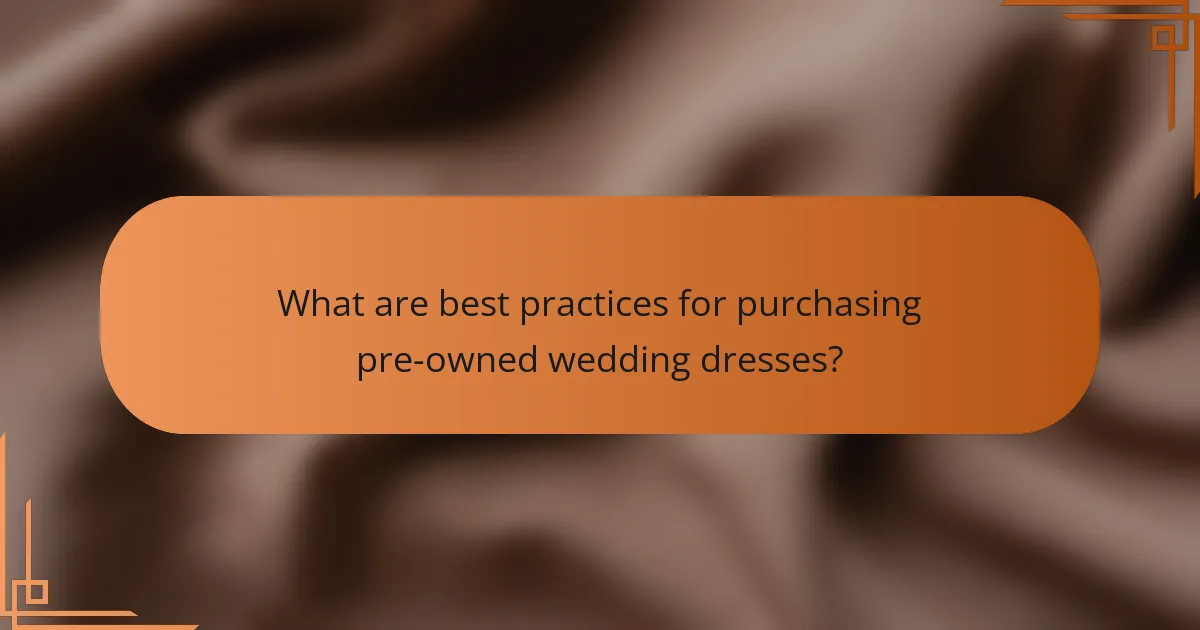
What are best practices for purchasing pre-owned wedding dresses?
Research the dress’s history before purchasing. Verify the seller’s credibility through reviews and ratings. Inspect the dress for any damages or alterations. Request detailed photos to assess the condition. Check for original labels and certificates of authenticity. Ensure the dress fits your size requirements or inquire about alterations. Understand the return policy before finalizing the purchase. Purchasing from reputable platforms increases the likelihood of a successful transaction.
How can you ensure a safe and informed purchase?
To ensure a safe and informed purchase of pre-owned wedding dresses, verify the authenticity of labels and certificates. Check for original tags from reputable designers, as these indicate authenticity. Request documentation that proves the dress’s origin and condition. Research the seller’s reputation through reviews and ratings. Confirm return policies to protect your investment. Utilize trusted platforms that specialize in pre-owned wedding dresses. These steps minimize risks and enhance confidence in your purchase.
What questions should you ask the seller about authenticity?
Ask the seller for proof of authenticity regarding the wedding dress. Inquire if they have original receipts or certificates of authenticity. Request details about the brand’s specific labels or tags. Ask if they can provide a history of the dress’s ownership. Confirm whether the dress has been authenticated by a third-party expert. Check if the seller has any documentation from previous sales or appraisals. Verify the dress’s condition and any alterations made. Ensure that the seller is willing to offer a return policy based on authenticity claims.
How can you research the brand and model of the wedding dress?
To research the brand and model of a wedding dress, start by examining the labels inside the dress. Labels typically include the designer’s name and the model number. Next, utilize online resources such as the designer’s official website or bridal fashion databases. These platforms often provide detailed information on specific collections and styles. Social media can also be a valuable tool; search for the dress using hashtags or join bridal groups for insights. Additionally, consult bridal boutiques or second-hand retailers, as they may recognize the dress and provide further details. For verification, cross-reference images of the dress with online listings to confirm authenticity.
What tips can help you navigate the pre-owned wedding dress market?
Research reputable sellers in the pre-owned wedding dress market. Look for established boutiques or online platforms with positive reviews. Verify the authenticity of the dress by checking labels and certificates of authenticity. Inspect the dress for signs of wear and damage before purchasing. Ask the seller for detailed photographs and descriptions. Compare prices to ensure you are getting a fair deal. Be cautious of deals that seem too good to be true. Finally, consider having the dress professionally cleaned or altered after purchase to ensure it meets your standards.
How can you spot red flags when assessing a pre-owned wedding dress?
Inspect the dress for visible damage or stains. Look for frayed seams, discoloration, or tears. Check the label for authenticity and brand details. Verify if the label matches the dress style and era. Assess the fabric quality; high-quality materials are less likely to show wear. Examine the stitching; irregular patterns can indicate poor craftsmanship. Request the original purchase receipt or certificate of authenticity if available. Ask the seller about the dress’s history and previous alterations.
What common mistakes should you avoid when buying pre-owned wedding dresses?
Common mistakes to avoid when buying pre-owned wedding dresses include not verifying authenticity. Many dresses lack proper labels or certificates. Failing to check for signs of wear can lead to costly surprises. Not asking about the dress’s history may result in missing important details. Ignoring size discrepancies can cause fitting issues later. Overlooking cleaning and alteration needs is another frequent error. Skipping a thorough inspection for stains or damages can lead to dissatisfaction. Lastly, neglecting to compare prices may result in overpaying for a dress.
The main entity of this article is the concept of authenticity in pre-owned wedding dresses. The article provides a detailed examination of how to verify the authenticity of these dresses through labels and certificates, emphasizing their importance in ensuring quality, value, and buyer confidence. It outlines the potential risks of purchasing non-authentic dresses, the impact of authenticity on resale value, and the key features to look for in labels and certificates. Additionally, it offers practical tips for verifying authenticity and navigating the pre-owned wedding dress market effectively.
